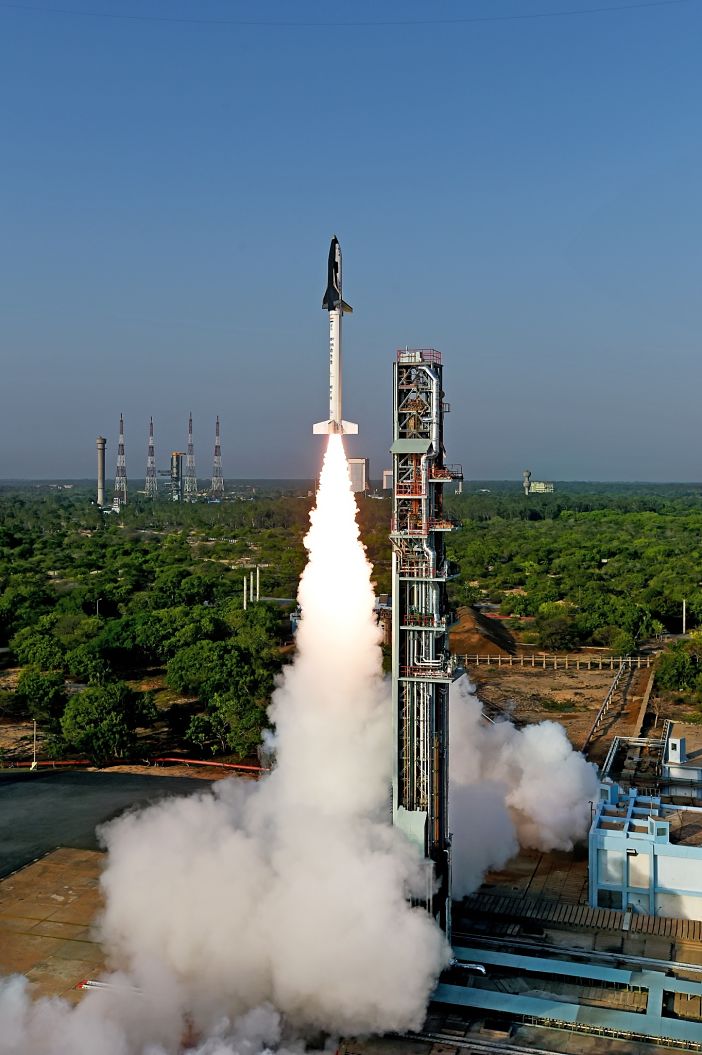[orc]ISRO successfully flight tested the Reusable Launch Vehicle – Technology Demonstrator (RLV-TD). When this is fully developed, the RLV-TD could significantly reduce the cost of launching satellites into the space.
On May 23rd, the Indian Space Research Organization (ISRO) successfully tested India’s first winged body aerospace vehicle operating in hypersonic flight regime that is known as the Reusable Launch Vehicle – Technology Demonstrator (RLV-TD). It marks a very important milestone in the journey to make a fully reusable launch vehicle in the future.
Why do we need a RLV?
At present, operational satellite launch vehicles in India are not reusable. These are designed to be used only once and their stages are not recovered for reuse. The launch vehicle typically consists of several rocket stages and the stages are jettisoned one by one during various phases of the mission as the launch vehicle gains desired altitude and speed. If a mission fails for any reason or is even successful, the launch vehicle is not reusable and the amount spent on the launch is wasted.
What is the RLV-TD?
The RLV-TD is a winged body vehicle weighing 1.5 Ton and was lofted to a height of 65 km using solid booster, thus attaining 5 times the speed of sound. Thereafter it descends by gliding and splashing down into the sea.
The Development of Reusable Launch Vehicles is a technical challenge and it involves development of many cutting edge technologies. A series of technology demonstration missions would be required before it could be used for launching.
In this experimental mission, the HS9 solid rocket booster carrying RLV-TD lifted off from the First Launch Pad at Satish Dhawan Space Centre, Sriharikota. After a successful flight of 91.1second, HS9 burn out occurred, following which both HS9 and RLV-TD mounted on its top coasted to a height of about 56 km. At that height, RLV-TD separated from HS9 booster and further ascended to a height of about 65km.
From that peak altitude of 65 km, RLV-TD began its descent followed by atmospheric re-entry at around Mach 5 (five times the speed of sound). The vehicle’s Navigation, Guidance and Control system accurately steered the vehicle during this phase for safe descent. After successfully surviving high temperatures of re-entry with the help of its Thermal Protection System (TPS), RLV-TD successfully glided down to the defined landing spot over Bay of Bengal, at a distance of about 450km from Sriharikota, fulfilling the mission objectives. The vehicle was successfully tracked during its flight from ground stations at Sriharikota and a shipborne terminal. Total flight duration from launch to landing of this mission of the delta winged RLV-TD, lasted for about 770seconds.
In the first flight, critical technologies such as autonomous navigation, guidance & control, reusable thermal protection system and re-entry mission management have been successfully validated.
Will it significantly reduce the cost of launching satellites?
The magnitude of cost reduction depends on development and realization of fully reusable launch vehicle and its degree of reusability. As on date, the launching of 2 ton class of communication satellite by Geosynchronous Satellite Launch Vehicle (GSLV) to Geosynchronous Transfer Orbit (GTO) costs Rs 173 crore. This cost could be significantly reduced if a completely reusable launch vehicle is built.
ISRO is also taking steps to develop next generation launch vehicle GSLV MkIII, capable of launching 4 ton class communication satellites to Geo-synchronous Transfer Orbit, which would bring down the cost of satellite launches.
Image and Video Source: ISRO





1 Comment
Pingback: Read, Learn, Improve – 4-Jun-16 | Random Thoughts of Analyst